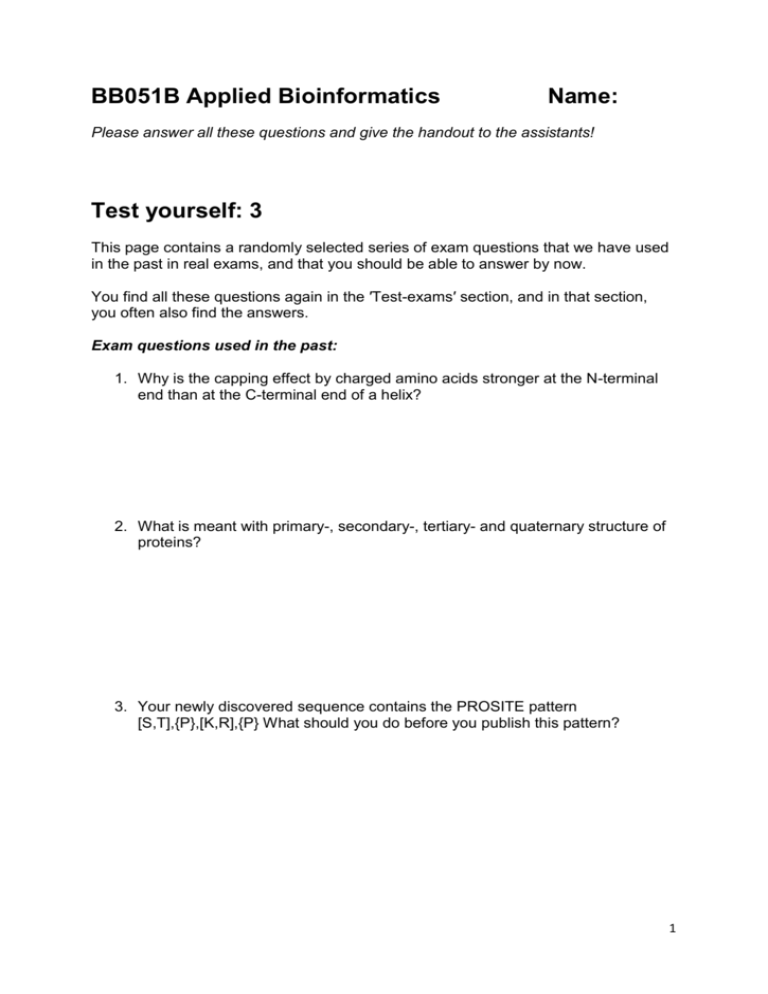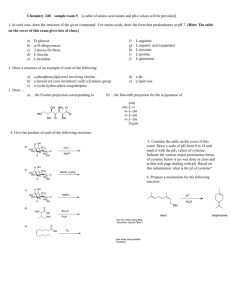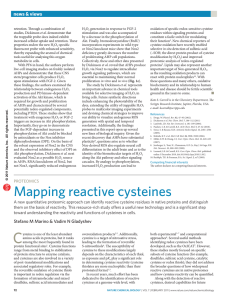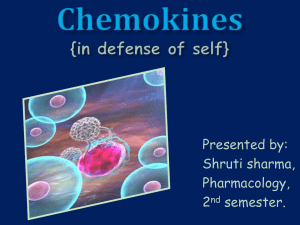Test yourself 3 and 4 as file
advertisement

BB051B Applied Bioinformatics
Name:
Please answer all these questions and give the handout to the assistants!
Test yourself: 3
This page contains a randomly selected series of exam questions that we have used
in the past in real exams, and that you should be able to answer by now.
You find all these questions again in the ′Test-exams′ section, and in that section,
you often also find the answers.
Exam questions used in the past:
1. Why is the capping effect by charged amino acids stronger at the N-terminal
end than at the C-terminal end of a helix?
2. What is meant with primary-, secondary-, tertiary- and quaternary structure of
proteins?
3. Your newly discovered sequence contains the PROSITE pattern
[S,T],{P},[K,R],{P} What should you do before you publish this pattern?
1
4. Draw a sequence of 14 amino acids of which the middle ten are perfectly
helical and the outer two at both ends not.
5. What do you think of the sequence VTVTGPVTVT?
Test yourself: 4
Question 108: A small part of the large protein nexistepas has as sequence:
ASSNTFECTVGPITWCVKSASNA
The rest of the sequence contains all thinkable amino acids but no cysteine. It was observed
that nexistepas changes its weight a little bit if it stands for many hours at pH 7.2 at room
temperature. And the weight change is compatible with the oxidation of one cysteine. Can
you help the group that works on nexistepas by predicting which of the two cysteines gets
oxidized?
Answer
Question 109: Are the Cysteines likely to be bridged or not in the following
sequence? Motivate your answer in just a few words.
SNSPDLCELLIKALIRLLAQACAGGSSN
Answer
Question 110: The C-terminal peptide of the protein kannietus from bacillus subtilis
has as sequence:
GIGSGPDLVAEFMMKAWLQGSS
2
We mutated the W into an R and got much better binding to a regulatory element.
The following sequence is the C-terminal peptide of the protein kannietus from the related
bacillus bacillus thermotaga:
SSAAELLRAFAQLLAMGGSASG
Which residue would you mutate in the kannietus from bacillus thermotaga to get the same
improved binding to the similar regulatory element in this bacillus? Motivate your answer in
less than 20 words.
Answer
Question 111: The slime mould mofope has a very small serine protease with the
sequence:
GSVEFKITSGGNGPAELLKALIQGSGSVTITWEVHGNGNSALELALQLLKGSGTVEFIDGNGN
Can you find its active site residues? Motivate your answer in less than 20 words.
Answer
Question 112: Use all 20 amino acid types exactly two times in total to design
peptides that strongly predict to become respectively:
1) α-helix; 2) β-strand; 3) β-hairpin; and 4) loop.
(So you have on average 10 amino acids per element).
Answer
Question 113: Which cysteine can be oxidized in this protein fragment:
NHSADCLMLALLSAACLMIFALLLGTSKKT
Answer
Question 114: A protein from the bacterium pocointellicus strongly triggers the human
immune system, but we want to use it in a human-rich environment anyway. Using
several techniques, this effect was found to originate from the peptide:
NHSADCLMLALLSAACLMIFALLLGTSKKT
Can you suggest a mutation that will make the whole protein less antigenic? (Hint:
look up the so-called positive-in rule).
Answer
Question 115: Maleimide spinlabels can be attached to proteins via a reaction with a
cysteine. In the peptide shown below, only one cysteine could be spinlabeled
because the other two seemed bridged to each other. Which cysteine can be
spinlabeled in:
3
SNGPAELCLKACLCALQALGGKS
Answer
Question 116: Are the cysteines likely to be bridged in:
SGGVTCTIEIGPVKIECVIRP
Answer
Question 117: Given the sequences ASDFGCHIKLMCNPQRSCTVW,
YSDYGCNIKLFCQPQRSCTWW, ATDYPVQIKLMCNPQKSCSMW,
YTDFGCHVKLLVQPNRSVTVW, and TDFGVHVKLMCNPQKSCSFW the question is
which of the cysteines are bridged?
Answer
This page contains a randomly selected series of exam questions that we have used
in the past in real exams, and that you should be able to answer by now.
You find all these questions again in the ′Test-exams′ section, and in that section,
you often also find the answers.
Exam questions used in the past:
1. Look at the sequence SSNPDLCLQACAKGGSGALEACIALCARLGSSN
How many cysteines do you count in it?
Which pairs of cysteines form bridges?
2. These two sequence predict to have the same secondary structure.
Which is that secondary structure?
And which of the two are you most certain of that it will actually adopt that secondary
structure in solution and why?
A) SGWEITVEGPKITFKV B) VKFKIENNTFKIEINT
3. Three of the following, aligned, sequences bind Calcium. Which three, and why do
you think that?
4.
SFTDALKNMKPYESSFTRIVN
5.
SYTDALKNVKPYESSFTRVVN
6.
SFTASLKNLKPYCSSFTRVIG
7.
SFTDALKLIVPYESSFTDVIH
8.
SWTAVLKLMVPYLSSFTDILR
9. Which cysteine can be oxidized in this protein fragment (an why?):
NHSADCLMLALLSAACLMIFALLLGTSKKT
10. Align CWEALALLAELALAAMKGSTPNGS with CWEALALLLEALMRGTTPNGG
11. Whatever I try, I can only bind the small organic molecule cystinofilus to one of the
cysteines in SNGPAELCLKACLCALQALGGKS. Which one, and why?
4











